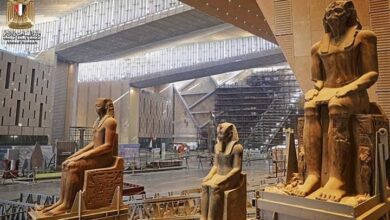On a Sunday afternoon, the garden of the Egyptian Museum in Tahrir Square is quiet. The only people on the premises, apart from the museum’s staff, are scores of Egyptian visitors, mostly students and families who have come to visit the country’s most prestigious cultural institution.
“This is my sixth visit to the museum,” says Ahmed Taylon, a student at Ain Shams University’s Faculty of Agriculture. “And it will definitely not be my last.”
Taylon likes to visit the museum every once in a while because it is impossible to see its vast collection on a single visit. He first learned about the museum in school at the port city of Rosetta, but was only able to visit it after he moved to study in the Egyptian capital.
Many residents of Rosetta would like to visit the museum as well, says Taylon, but they have little practical information about it to be able to organize a trip down to Cairo.
“Why not have TV or radio advertisements, informing the public about its opening hours and other practical information?” he asks.
Taylon seems to have a point: Practical information for visitors can only be obtained at the museum itself. There are no newspapers, TV or radio announcements for the institution. Fliers and brochures are not available either. And the museum’s official website has not been updated in years.
What seems to facilitate Taylon’s repeated visits to the museum is the nearby Sadat metro station.
“Commuting with the metro is fast, cheap and convenient,” he says.
Although Cairo’s underground metro network is still under development, it serves millions of passengers, particularly in congested areas like downtown. Taylon was surprised to hear that in three years time, most of the Tahrir museum’s collection will be moved to the Grand Egyptian Museum, west of the Giza pyramids, a project he had never heard of. To be located on the remote, yet crowded, road linking Cairo to Fayoum, easy and affordable transportation could be a major challenge to Egyptian visitors, compared with foreign tourists who will mostly visit the museum through organized tours that include transportation.
The current Tahrir museum lacks explanatory plaques and labels, as well as educational kits for the artifacts on display, a problem that could continue to plague the future museum, says Azza Mohamed, a nurse from Fayoum who is visiting the downtown museum for the first time.
“If the state is planning for a grand museum, labels and plaques should be a priority,” she said.
The state is indeed moving forward with the project. On Monday, Antiquities Minister Mohamed Ibrahim Ali announced the first day of work on the third and final phase of the Grand Egyptian Museum in an international press conference.
“We are sending a message to the whole world that we are proceeding with our project and that everything is going according to plan,” he told the press.
Attended by the teams working on the project, as well as representatives of the United Nations Educational, Scientific and Cultural Organization and the Japanese International Cooperation Agency — the latter is funding the GEM — the press conference covered security preparations, conservation labs, the planned collection, and even the estimated number of tourists that will visit. However, little mention was made of the vision for the new museum’s relationship with the local community — how it plans to attract Egyptian visitors, the services it will offer to various age and social groups, and plans to improve transportation.
“The GEM is a global cultural project, especially for Egyptians,” Mohamed Gamal, supervisor of the archaeological and musicological administration at the GEM, told Egypt Independent after the press conference. “Since I joined the team nine years ago, I’ve been working with the spirit of making the GEM a center of culture and knowledge for all Egyptians.”
Gamal had previously told Egypt Independent about the museum’s plans to hold workshops and seminars for the public, as well as present information in an interesting and accessible way to visitors.
The crowded location of the GEM still raises concerns, though, as it is located at a convergence of several main roads and highways of Greater Cairo. The area is not densely populated. A comprehensive plan to upgrade the highways surrounding the GEM’s site has been drawn to ease the expected pressure on the area once the museum opens to the public, says Gamal.
But one would need to commute using a car, unlike the convenient location of the Tahrir museum surrounded by metro stations and bus stops. Cairo’s yet un-built fourth metro line, which would run from 6th of October City to the existing Al-Malek al-Saleh stop south of the city center, is slated to have a stop at the GEM site. Hopefully this will help the “the world’s largest archaeological museum” better serve local communities, as well tourists.




